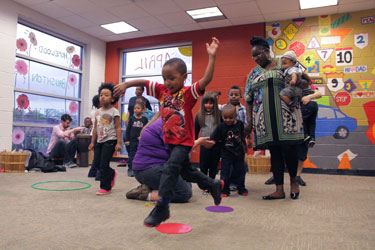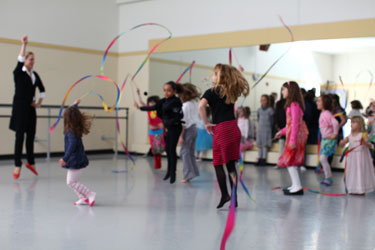4 Reasons to Dance with Your Kids
by Christina Salgado, Director of Education

Exciting. Fun. Active. Enjoyable.
At the start of my creative movement workshops I often pose the question: What does movement education mean to you? These are some of the responses I hear. I’ll often jot down shared thoughts and then proceed with the presentation. After exploring the fundamental components of creative movement through open discussion and actually inviting individuals to actively engage in activities, I will return to my initial question. The answers always bring a smile to my face and I’ll often glance back at the original responses to see how they have changed. Movement education suddenly evolves into an opportunity for children to use their imaginations, gain self-awareness, understand emotions, and develop cognitive connections. Of course it’s impossible to overlook the fun factor of dance, but there is such depth to the other benefits children can experience.
PBT was lucky enough to be a part of Pittsburgh Association for the Education of Young Children UnConference this summer which brought together arts organizations that emphasize the importance of the arts in early childhood education. Here are some of the benefits of creative movement highlighted in our presentation:

1. Creative movement builds social competence. Children are frequently exposed to emotions through creative movement and asked to explore how to express these emotions in non-verbal ways. This often helps children socially connect with other children on a deeper level.
2. Creative movement provides opportunities to build self-regulation through activities that require impulse-control. Throughout each class children are asked to start and stop on cue, wait in line for their turn, and to be aware of their personal space as well as their peers’ space. These simple tasks all require children to regulate and control their actions.
3. The musical aspect of creative movement allows children to understand rhythms and gain temporal awareness. Clapping to the music, changing movement quality to reflect the rhythm of a song, and counting to the beat of the music are all components of creative movement that foster temporal awareness. This translates well to literacy development and can help children build their phonological awareness.
4. Children are given the opportunity to creatively explore and use their imagination. As children make sense of the world they often create their own hypotheses and then test what they think to be true. Children will use their imagination to drive this process. Creative movement nurtures this by giving children the creative license to discover new concepts through their own inquiry.
PBT offers a variety of Creative Movement programs, Professional Development workshops and other ways to integrate movement in everyday lessons. Here is an activity to try at home or in the classroom to spark creativity and build understanding of personal space.
The Body Bubble
- Find an open space and invite your child to play and dance with you.
- Tell your child that you are going to try an activity called the “Body Bubble.”
- Ask your child about bubbles. What are some characteristics? How do they move? Are they transparent? What causes them to pop?
- Start off small on the ground and begin by pretending to blow up your bubble using your breathe to fill the bubble all around you. Stand tall and reach all the way over your head, in front of you, and behind you.
- Now it’s time to paint your bubble. Ask your child to pick his/her favorite color and to paint his/her bubble all around.
- Explain that this is your personal space and you don’t want to pop your bubble or anyone else’s bubble when you dance around the room.
- Now try moving like a bubble. You can float through the space, bounce from one end of the room to another, or glide from one corner to the next.
- Have fun exploring and learning together!
